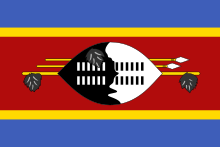
Back Història de Swazilàndia Catalan Geschichte Eswatinis German Ιστορία του Εσουατίνι Greek Historia de Suazilandia Spanish Histoire de l'Eswatini French היסטוריה של אסוואטיני HE Szváziföld történelme Hungarian Էսվատինիի պատմություն Armenian Historio di Eswatini IO Storia dell'eSwatini Italian

Artifacts indicating human activity dating back to the early Stone Age have been found in the Kingdom of Eswatini. The earliest known inhabitants of the region were Khoisan hunter-gatherers. Later, the population became predominantly Nguni during and after the great Bantu migrations. People speaking languages ancestral to the current Sotho and Nguni languages began settling no later than the 11th century.[1] The country now derives its name from a later king named Mswati II. Mswati II was the greatest of the fighting kings of Eswatini, and he greatly extended the area of the country to twice its current size. The people of Eswatini largely belong to a number of clans that can be categorized as Emakhandzambili, Bemdzabu, and Emafikamuva, depending on when and how they settled in Eswatini.
- ^ Bonner, Philip (1983). Kings, Commoners and Concessionaires: The Evolution and Dissolution of the Nineteenth-Century Swazi State. Cambridge: Cambridge U. Press. See esp. pp. 60, 85–88.
© MMXXIII Rich X Search. We shall prevail. All rights reserved. Rich X Search